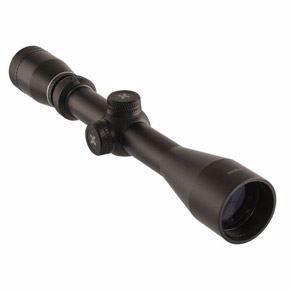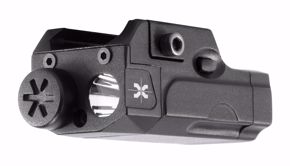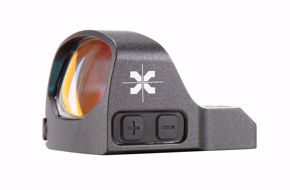The Axeon Second Zero long-distance rifle accessory does one thing, and only one thing. It bends light. Simple enough. Axeon Optics offers two specific recipes within the Second Zero offering, 4.3 MOA and 11.5 MOA. Why these two? Because these are based on an average of the most popularly sold hunting rounds. Meaning that by calculation it is known that most bullets will hit the kill zone of a target whether it is at 285 yards, 365 yards, or somewhere in between. For most high-velocity rounds the 4.3 MOA Second Zero will give the shooter an additional zero at the +-330 yard mark. Likewise, 11.5 MOA will adjust most high-velocity rounds to an additional zero of +-530 yards.
 Between 100 and 200 yards, most high-velocity rounds will be within an inch or two of the point of aim. There is no need for any significant amount of “holdover” that the shooter has to accommodate for. But, beyond 200 yards, the bullet is slowing down and starts to drop in a greater arc. That does not mean that it drops faster. The bullet drops at the same speed whether it is going 3,000 FPS or 0 FPS. As it gets farther from the blast that propelled it, the bullet slows down its travel on the X-axis while approaching the X intercept, i.e. the ground (downward travel on the Y-axis—and you thought you were done with math!).
Between 100 and 200 yards, most high-velocity rounds will be within an inch or two of the point of aim. There is no need for any significant amount of “holdover” that the shooter has to accommodate for. But, beyond 200 yards, the bullet is slowing down and starts to drop in a greater arc. That does not mean that it drops faster. The bullet drops at the same speed whether it is going 3,000 FPS or 0 FPS. As it gets farther from the blast that propelled it, the bullet slows down its travel on the X-axis while approaching the X intercept, i.e. the ground (downward travel on the Y-axis—and you thought you were done with math!).
By the time a bullet reaches the 300-yard mark, the average hunting round will see a vertical (Y-axis) drop of 7-12 inches. That is significant. Significant enough that holdover correction will have to be made or your shot will not hit its intended target. Going out to 500 yards is a big step for most shooters, especially shooters who haven’t shot much at longer ranges before. At 500 yards you might see 4-7 feet of drop depending on what round you are shooting.
It needs to be said here that while these two angles of correction affect most hunting rounds at these distances, it doesn’t affect all rounds to the same distances. The same MOA, yes! The same distances, no! Take the .45-70 Gov’t for instance. This fat flyer is slow-moving and requires a “rainbow” trajectory to get out beyond 300 yards. Using an Axeon Second Zero with 4.3 MOA adjustment will allow you to access usable range from about 140 to 200 yards by simply flipping the Second Zero in front of your optic. More on this usable range for the Second Zero in just a minute.
How To Hold Over On Long Distance Shots
 There have been two, make that three ways, shooters have dealt with correcting for distance in the past. The first method is just to guess. The whitetail is “about” three hundred yards out, so hold “about” the top of the deer’s shoulder. If your educated guess was good, the backstrap was on the plate that night. If it wasn’t, you had a good story and a can of beans for supper.
There have been two, make that three ways, shooters have dealt with correcting for distance in the past. The first method is just to guess. The whitetail is “about” three hundred yards out, so hold “about” the top of the deer’s shoulder. If your educated guess was good, the backstrap was on the plate that night. If it wasn’t, you had a good story and a can of beans for supper.
The second method is to use the elevator in your scope to adjust accordingly. If you had a decent enough rifle scope that allowed you to “zero” the turret, you could turn the knob the appropriate number of clicks to adjust for the shot. Assuming a 100 yard zero, and a perfectly metered 300 yard shot and a known drop of 10 inches, 13 quarter MOA clicks on the vertical dial would put you just about perfectly on target. Squeeze the shot off and science teaming up with precision manufacturing puts deer meat in the freezer. Just remember to turn the elevation back to your zero and you are ready for another hunt.
And lastly, the modern drop compensating reticle. If you did your homework, and if the calculations used to make the reticle match your rifle and ammo well enough you will be ok, or close enough for horseshoes and hand-grenades. Or you might not. While these reticles are all the rage these days, they can offer less-experienced shooters more problems than solutions. What barrel length was used to figure these arbitrary holds on the reticle? What grain projectile? What shape of projectile was used? What velocity did this mystery round generate at the muzzle? Back to question one. See how that could be challenging?
That scope with the fancy reticle that you paid good money for might be the greatest thing since sliced bread for a 55-grain flat-based bullet fired from a 16” 1:9 twist barrel. But you are shooting prairie dogs with a 50-grain boat tail bullet from a 24 inch 1:12 twist barrel. Out to 200 yards no prairie dog will know the difference, but at 300, 350, 400 yards you’ll be hard-pressed to be absolutely sure where the shots are really landing. Changing just one of these variables will eliminate the perceived advantage of the scope. Change more than one and you might as well have not bought the scope at all.
What is the Usable Shooting Range of the Second Zero?
Remember, for the most part, a shot at 100 yards is going to be within a couple of inches at 200 yards. A shooter aware of this can simply hold “a tad” high and be right on the money. This same idea also addresses a target that is at 50 yards. The shot should land a little low as it is climbing to the line of sight of the optic. This same concept can be used with the Axeon Second Zero. The unit will indeed produce a true and exact “second zero”, but there is likewise a range along the Y-axis where the bullet will land a little high or a little low and still make a perfectly acceptable shot in the vital zone.

Let’s take a look at a 150 grain .308 trajectory for a minute. This common hunting round and bullet is used extensively to harvest game all over the U.S. Zeroed at 100 yards, this round will land about 4 inches low at 200 yards. This is about 2 MOA if you are keeping track of it that way. The shooter can simply hold a “hair” high and be satisfied with that shot. However, by 260 yards, this round will have dropped about 9.5”. At 300 yards, the drop is about 15” and at 350 yards it has fallen just over two feet. Engaging the Axeon Optics Second Zero with your optic will give you a new range where some slight corrections will lead to success, just as it did with the range of shots taken from the 100 yards zero.
A 4.3 MOA correction will allow the bullet to print about 2.2” high at 260 yards. The new “second zero” will occur at 290 yards and at 320 yards the bullet will land about 3.2” (1 MOA) low. Just like you are able to shoot 50-100-200 (150-yard range) with a rifle set to a 100 yards zero, you can use the Second Zero to engage a target in a range from 260-290-320 (60 yards).
Just Aim Center with the Second Zero
We’ve taken a few common rounds and created a chart to exemplify the concept (see chart). However, there are all sorts of combinations that are not mentioned here. What an Axeon Second Zero will do for your wildcat or subsonic round is defined in principle above. If you’ve used a ballistic calculator to attain the drop for that round, some relatively simple computations can be used to calculate the range the Second Zero will effect. To find the Second Zero distance, comparing the bullet drop data in MOA until you find the location where the bullet will be at 4.3 MOA. Subtract 1 MOA to find the low end of the range and add 1 MOA to find the upper end of the range.
The Second Zero is a fast, simple, effective way to make a range correction when shooting at a distance that you wouldn’t normally be comfortable with. Taking the guesswork out of hunting and shooting is a good thing. For more information on the Second Zero, go to www.axeonoptics.com/second-zero.
Opening up this “second zero” range is liberating. As quickly as you can flip the glass down, you have “turned on” a new level of performance for your rifle with no guesswork. This is a simple and reliable way to build up the confidence to take that longer shot.






https://broncos-game.org/ Denver Broncos Game online
https://colts-game.com/ Indianapolis Colts Game online
https://broncos-game.org/ Denver Broncos Game online
https://colts-game.com/ Indianapolis Colts Game online
<strong><a href="https://colts-game.com/">Watch Colts Live</a></strong>
<strong><a href="https://browns-football.com/">Watch Browns Live</a></strong>
<strong><a href="https://broncos-game.org/">Watch Broncos Live</a></strong>